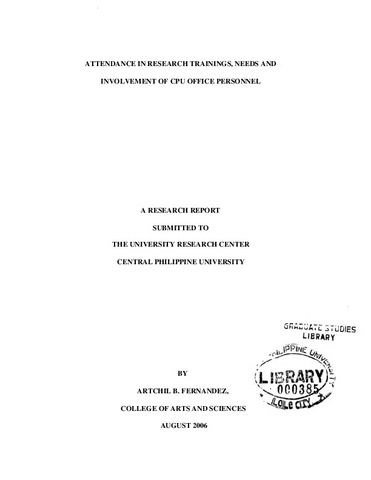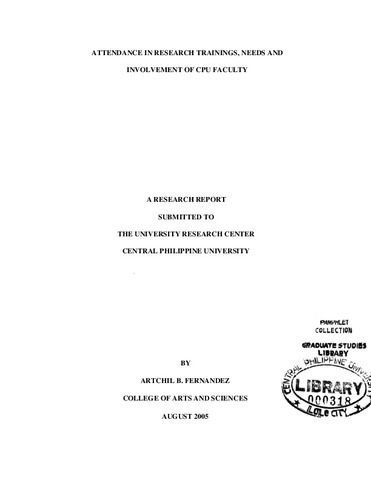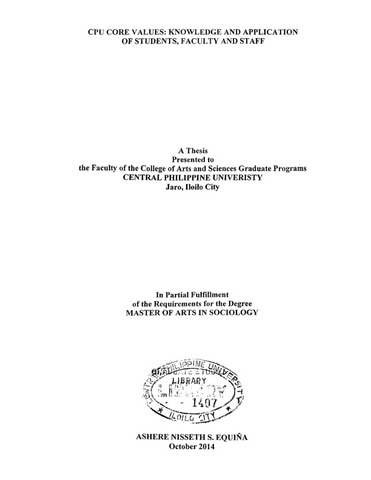Показать сокращенную информацию
Perceived sources and levels of stress among Central Philippine University employees
| dc.contributor.author | Alibogha, Salex E. | |
| dc.contributor.author | Concepcion, Ester L. | |
| dc.contributor.author | Querol, Faith Leila A. | |
| dc.date.accessioned | 2021-03-19T04:26:23Z | |
| dc.date.available | 2021-03-19T04:26:23Z | |
| dc.date.issued | 2003-09 | |
| dc.identifier.citation | Alibogha, S. E. , Concepcion, E. L. , & Querol, F. L. A. (2003). Perceived sources and levels of stress among Central Philippine University employees. Patubas, 1(1), 67-77. | en_US |
| dc.identifier.issn | 1908-515X | |
| dc.identifier.uri | https://hdl.handle.net/20.500.12852/618 | |
| dc.description | Journal article | en_US |
| dc.description.abstract | A study on the perceived sources and levels of stress was conducted among 151 faculty and staff at Central Philippine University for school year 1999-2000. The Social Readjustment Rating Scale (Holmes & Rahe, 1967) was modified to assess the extent of stress an individual is exposed to. From a list of life events, respondents were asked to rate the extent by which these stressors had affected them. Many of the respondents indicated that the perceived sources of stress had affected them to some extent. Results revealed that inadequate pay, unfair performance rating and lack of supportive superiors and administrators affected them to some extent. In terms of working conditions or atmosphere, all of the perceived sources of stress presented to them were rated to affect them to some extent and the top three stressors were too much noise, inadequate ventilation, and limited working conditions. Among the forty-three life events considered that have occurred in the last five years which caused them to feel tension and needs readjustment to their lives, death of a close family member, Christmas and personal injury or illness and vacation top the list while trouble with boss, jail term and marital separation ranked the least. An alarming 89 employees from the 151 respondents (59 percent) is expected to get sick the following year as caused by these stressors. Furthermore, the hassles of daily life affected them to some extent while the greatest micro-stressor that contributed to their distress and illness was having too many things to do. On the other hand, among the ten uplifts of life or motivators presented and considered by the respondents, completing a task ranked first, followed by spending time with family and feeling healthy or relating well with spouse or lover. The majority of faculty respondents claimed that exposure to chalk dust, infectious agents and illnesses in hospital and community, travel and exposure to hazardous chemicals, fumes and microorganisms were hazardous to their health while exposure to computer radiation was reported risk by staff members. The most common health problems presented were Upper Respiratory Infection and its accompanying symptoms like cough, colds, running nose, sore throat, headache and fever. Other reported illnesses were hypertension, asthma, allergy, rheumatism/arthritis, ulcer, hyperacidity, migraine and diabetes mellitus. | en_US |
| dc.language.iso | en | en_US |
| dc.publisher | Central Philippine University | en_US |
| dc.subject.lcsh | Stress (Psychology) | en_US |
| dc.subject.lcsh | Job stress | en_US |
| dc.subject.lcsh | Stress management | en_US |
| dc.subject.lcsh | Central Philippine University | en_US |
| dc.subject.lcsh | Central Philippine University--Employees | en_US |
| dc.subject.lcsh | Central Philippine University--Faculty | en_US |
| dc.subject.lcsh | Central Philippine University--Professional staff | en_US |
| dc.subject.lcsh | Universities and colleges--Faculty | en_US |
| dc.subject.lcsh | Universities and colleges--Professional staff | en_US |
| dc.subject.mesh | Stress, Psychological | en_US |
| dc.subject.mesh | Faculty | en_US |
| dc.title | Perceived sources and levels of stress among Central Philippine University employees | en_US |
| dc.type | Article | en_US |
| dc.citation.firstpage | 67 | en_US |
| dc.citation.lastpage | 77 | en_US |
| dc.citation.journaltitle | Patubas | en_US |
| dc.citation.volume | 1 | en_US |
| dc.citation.issue | 1 | en_US |
Файлы в этом документе
Данный элемент включен в следующие коллекции
-
Journal articles [3]
-
Patubas [110]
Patubas is a refereed research journal of Central Philippine University.





